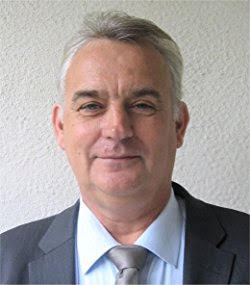
Solange Ghernaouti (Swiss Cybersecurity Advisory & Research Group, University of Lausanne)
Title: A prospective approach of cybersecurity and cyberdefence to improve security, stability and peace in cyberspace and in real world
Abstract: Cyberspace is a new space where all sorts of activities are deployed for the best and the worse of people, organizations and states. It allows, among other things for example to influence, to destabilize, to spy, to destroy or to make crimes. It is an instrument at the service of economic profitability and a place of expression of power. It is in fact a strategic territory that’s should be protected and defended. After having presented the evolution of the global digital ecosystem, being developed at the international level, and from which the society is becoming more and more dependent, we analyze the impact of cyberrisk on it. Based on real cases, we discuss current and future challenge of cybersecurity and cyberdefense issues from civilian and military perspectives and we examine key factors of success to master cyberrisk for public or private institutions at a strategic and operational levels. A particular focus will be given on capacities building, education, research, Human right protection, privacy, the fight against cybercrime related issues.Biography: Solange Ghernaouti helds a Phd in Computer Science and Telecommunication (Paris VI University), she is former auditor of the French Institute of Advanced Studies in National Defence. She is professor of the University of Lausanne and Associate Fellow of the Geneva Center for Security Policy, Director of the Swiss Cybersecurity Advisory and Research Group. She is an internationally recognized expert on cyberrisk governance, cybersecurity, cyberdefence and cybercrime related issues. She has contributed to several initiatives organised by international organisations, public and private institutions, research centres, and law enforcement agencies, among other instances of professional recognition all around the globe. She is an active independent security advisor, an influential analyst and a regular media commentator. Professor Ghernaouti has authored more than 300 publications and more than thirty books on ICT and security issues, including “Cyberpower: Crime, Conflict and Security in Cyberspace” (EPFL press 2013, translated in China) and the “Cybersecurity guide for developing countries” (ITU first edition 2006). Solange Ghernaouti is Chevalier de la Légion d’Honneur and has been recognised by the Swiss press as one of the outstanding women in professional and academic circles, she is member of the Swiss Commission for UNESCO and of the Swiss Academy of Technical Sciences.
Key words : Cyberpower, Cybersecurity strategy, Cyberdefence, Fighting cybercrime, Cyberresilience, Research & education challenges, Capacity building, State sovereignty.
Email : sgh@unil.ch
Web : www.scarg.org

Michele Nogueira (Federal University of Paraná, Brazil)
Title: The Cat-and-Mouse Game: Searching for Security Intelligence in the Era of IoT and Blockchain
Abstract: Cybercrimes are constantly damaging company reputations and increasing costs. More and more, we experience attacks with high impact on companies and society. In May 2017, for instance, the WannaCry ransomware infected more than 230000 computers, encrypting data and demanding ransom payments in the Bitcoin cryptocurrency. Another example, in October 2016, the Dyn cyberattack took place involving distributed Denial-of-Service attacks (DDoS attacks) launched from Internet-connected devices -- such as IP cameras, residential gateways and baby monitors -- causing major Internet platforms and services to be unavailable to many users in Europe and North America. These examples highlight the power of the cyberattacks, but mainly reveal a constant improvement and sophistication in attacker strategies. For sure, cybersecurity isn’t anymore what it used to be. We are in the era of ubiquitous systems, in which we expect more than 50 billion of devices (things) connected by 2020. We observe the design of different solutions, such as the digital passports for seamless entry at Dubai Airport, supported by the blockchain technology, expecting it stands as proof of all the transactions on the network. However, how is academia addressing the sophistication in cyberattacks? Are we being able to anticipate moves in this cat-and- mouse game against attackers? How could academia benefit from the data generated in the network to create a security intelligence and prevent from attacks? This talk intends to promote a discussion around these questions and present an overview of correlated researches developed by Dr. Nogueira’s research team and future directions in these topics.Biography: Michele Nogueira is Professor of the Computer Science Department at Federal University of Paraná, where she has been since 2010. She received her doctorate in Computer Science from the University Pierre et Marie Curie – Sorbonne Universités, Laboratoire d’Informatique de Paris VI (LIP6) in 2009. Her research interests include wireless networks, security and dependability. She has worked on providing resilience to self-organized, cognitive and wireless networks by adaptive and opportunistic approaches. Dr. Nogueira was one of the pioneers in addressing survivability issues in self-organized wireless networks, being the works “A Survey of Survivability in Mobile Ad Hoc Networks” and “An Architecture for Survivable Mesh Networking” her prominent scientific contributions. She has been a recipient of Academic Scholarships from Brazilian Government on her undergraduate and graduate years, and of international grants such as from the ACM SIGCOMM Geodiversity program. She is also Associate Technical Editor for the IEEE Communications Magazine and the Journal of Network and Systems Management. ACM and IEEE Senior Member.

Pascal Urien (Mines-Telecom, Paris)
Biography: Pascal Urien is full professor at Telecom ParisTech. He graduated from Ecole Centrale de Lyon, and received a PHD in computer science. He holds an HDR (Habilitation for Director of Researches), Section 27 (2000) He worked in CNET de Lannion, Thomson LCR (Laboratoire Central de Recherches), CGCT (Compagnie Generale des Constructions Telephoniques), MET (Matra Ericsson Telecomunication), BULL SA, BULL CP8, SCHLUMBERGER, SCHLUMBERGER-SEMA. He taught in CNAM (Conservatoire National des Arts et Métiers), University of Marne la Vallee, and was half-time professor in the University of Paris Dauphine. His main research interests include security and secure elements (smart cards), especially for wireless networks and distributed computing architectures. He holds 15 patents and wrote about one hundred publications in these domains. He is the father of the internet smart card technology, which won two industrial awards, Best Technological Innovation at cartes'2000 (Paris) and Most Innovative Product of Year at the Advanced Card Award 2001 (London). He invented the EAP smart card, that won two industrial awards, Best Technological Innovation at cartes'2003 (Paris), and Breakthrough Innovation Award at CardTech/SecureTech 2004 (Washington DC).